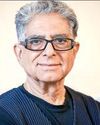ECONOMIC ADVISER in the Ministry of Defence, Rajib Kumar Sen is credited with formulating policies on defence offsets. He is also closely associated with the budgeting plan for the Indian armed forces. In an exclusive chat with Manish Kumar Jha, Sen talks about the Draft Defence Production Policy and offsets and how changes in it will enable domestic manufacturers to meet high quality military hardware requirements.

The Draft Defence Production (DDP) Policy 2018 aims to make India one of the world’s top five defence manufacturing hubs by 2025 with self-reliance in 13 areas and achieve exports of Rs 35,000 crore ($5 billion). How realistic is the vision?
This has been drafted keeping the future in mind. It is not yet approved, but the process is on. I think it is a very good document to follow. It is a bit ambitious but I think we have to be ambitious if we have to achieve something, specially the export target of Rs 35,000 crore, which may look very high but there his potential. I think it makes a lot of sense to try achieving these goals.
Assuming the economy grows at 7 per cent on an average, in order to achieve the export target stated in the draft policy, the defence sector will have to grow at 15-20 per cent on a consistent basis. Is the target unrealistic?
It has nothing to do with percentages. As you know, the defence sector has lots of negative areas. For instance, we cannot buy from certain countries, we cannot sell to certain countries. It is not as if we are factoring in only economic growth. For instance, we are buying so many things from Russia, and we are also opening up to the US – the US has technology and sharing has started. So, we are looking at countries that are friendly towards us, especially the Asean and African countries. There is a lot of scope for export as many of the exportable items already exist with us. Some of these items have yet to be fully indigenised but we are in the process of doing so. So, given these capabilities I don’t’ think that the export target will be dependent only on high economic growth. We are in a position to exploit and increase our exports within the current rate of economic growth.
How do you think it’s possible? We would like to understand why we have not attracted enough FDI in defence?
هذه القصة مأخوذة من طبعة August 18, 2018 من Businessworld.
ابدأ النسخة التجريبية المجانية من Magzter GOLD لمدة 7 أيام للوصول إلى آلاف القصص المتميزة المنسقة وأكثر من 9,000 مجلة وصحيفة.
بالفعل مشترك ? تسجيل الدخول
هذه القصة مأخوذة من طبعة August 18, 2018 من Businessworld.
ابدأ النسخة التجريبية المجانية من Magzter GOLD لمدة 7 أيام للوصول إلى آلاف القصص المتميزة المنسقة وأكثر من 9,000 مجلة وصحيفة.
بالفعل مشترك? تسجيل الدخول

Gauging Trumponomics For India
Despite some shortto mediumterm headwinds in trade and immigration, the broader Indo-US vision of counterbalancing China’s influence is expected to ensure continued cooperation under Trump 2.0

Reflections on Consciousness and Creation
Indian-American DEEPAK CHOPRA on the nature of the universe, the digital fabric of existence, and the power of a conscious mind

MORE TAKE TO DRIVING IN STYLE
High-end luxury vehicles are no longer part of a niche market, but a rapidly expanding segment of automobile sales, driven by changing consumer preferences, rising disposable incomes and better infrastructure

India's Growing Affinity for Swiss Watches: A Luxury on the Rise
NDIA'S ROBUST ECONOMIC growth, projected to exceed 6 per cent in 2024 and 2025, is fostering a rising demand for aspirational products. As disposable incomes increase, particularly among the expanding middle class, luxury goods such as Swiss-made watches are gaining popularity.

An ENRiching Outlook
KPMG's latest report shows energy CEOs being optimistic about the sector's outlook. ANISH DE, Global Head, ENRC, KPMG speaks to BW Businessworld's Arjun Yadav on what's driving this confidence

Paving the Path to a Sustainable Future
Salesforce's ESG journey has made an impact beyond the company. SUNYA NORMAN, SVP of ESG Strategy and Engagement at Salesforce, shares more on how the tech giant integrates sustainability into its core operations, supporting global goals while empowering employees

LEADERSHIP TRANSITION AT XIAOMI INDIA
Xiaomi India is experiencing a leadership evolution, beginning with Muralikrishnan B's departure as President by the end of 2024. This change underscores Xiaomi's shift towards nurturing local talent amidst dynamic global shifts. The story tracks key transitions from Manu Kumar Jain's leadership to Muralikrishnan B's impactful tenure, along with recent strategic hires, highlighting Xiaomi's alignment towards market adaptability and consumer focus

WEAVING SUSTAINABILITY
Once a modest home textile manufacturer, Jindal Worldwide has evolved into a vertically integrated textile powerhouse, spanning critical segments of the yarn and fabric value chain

FORCE FOR GOOD
FY24 saw capacity expansions for Century Enka in nylon and polyester segments, along with investments in modernisation, renewable energy, and safety initiatives

REIMAGINING TOMORROW
For V-Guard, tomorrow signifies progress, driven by today's actions, setting the foundation for future growth and value creation for all stakeholders